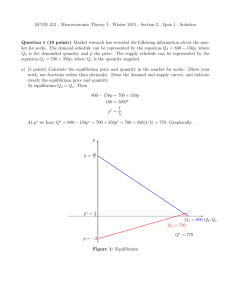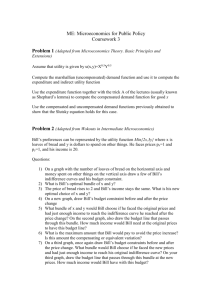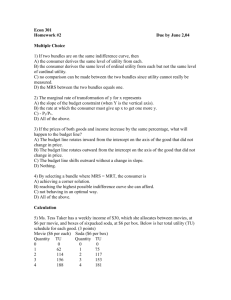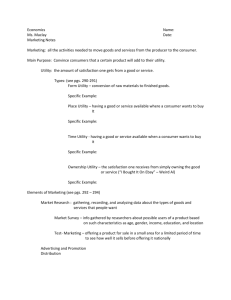Problem Set 2 Solution - Department of Economics
advertisement
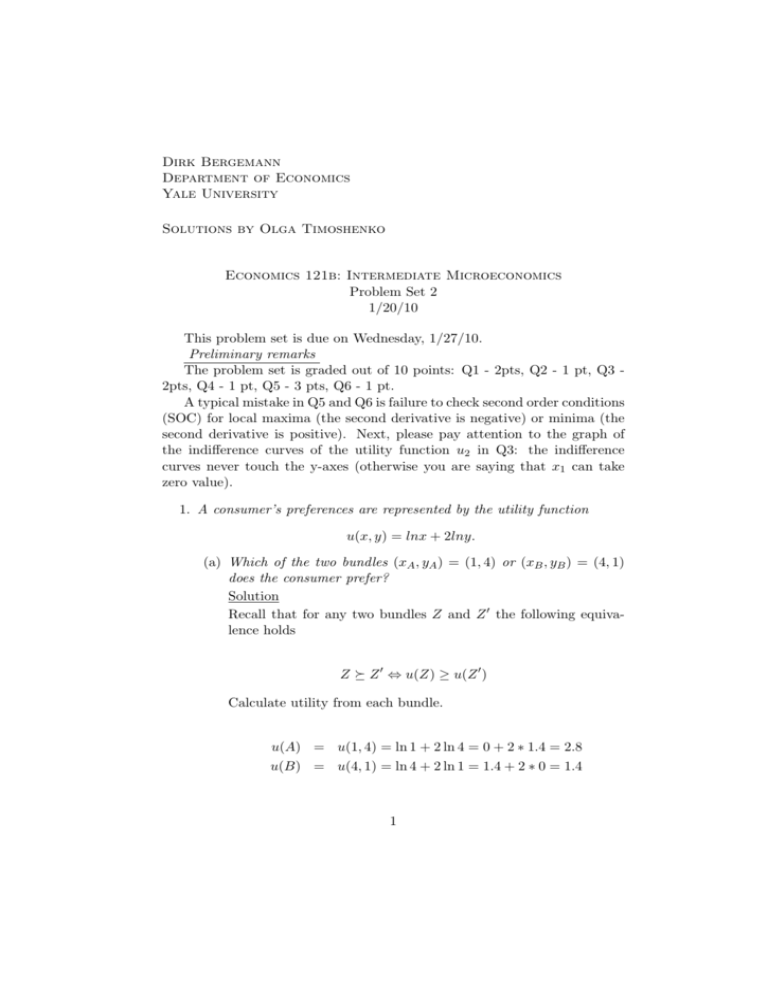
Dirk Bergemann
Department of Economics
Yale University
Solutions by Olga Timoshenko
Economics 121b: Intermediate Microeconomics
Problem Set 2
1/20/10
This problem set is due on Wednesday, 1/27/10.
Preliminary remarks
The problem set is graded out of 10 points: Q1 - 2pts, Q2 - 1 pt, Q3 2pts, Q4 - 1 pt, Q5 - 3 pts, Q6 - 1 pt.
A typical mistake in Q5 and Q6 is failure to check second order conditions
(SOC) for local maxima (the second derivative is negative) or minima (the
second derivative is positive). Next, please pay attention to the graph of
the indifference curves of the utility function u2 in Q3: the indifference
curves never touch the y-axes (otherwise you are saying that x1 can take
zero value).
1. A consumer’s preferences are represented by the utility function
u(x, y) = lnx + 2lny.
(a) Which of the two bundles (xA , yA ) = (1, 4) or (xB , yB ) = (4, 1)
does the consumer prefer?
Solution
Recall that for any two bundles Z and Z ′ the following equivalence holds
Z ≽ Z ′ ⇔ u(Z) ≥ u(Z ′ )
Calculate utility from each bundle.
u(A) = u(1, 4) = ln 1 + 2 ln 4 = 0 + 2 ∗ 1.4 = 2.8
u(B) = u(4, 1) = ln 4 + 2 ln 1 = 1.4 + 2 ∗ 0 = 1.4
1
Thus, since u(A) > u(B) the consumer prefers bundle A to bundle
B.
(b) Take as given for now that this utility function represents a consumer with convex preferences. Use this information and your answer to part (a) to determine which of the two bundles (xC , yC ) =
(2.5, 2.5) or (xB , yB ) = (4, 1) the consumer prefers. Verify your
answer.
Solution
Convex preferences imply that for any three bundles X, Y, and
Z, if Y ≽ X and Z ≽ X then αY + (1 − α)Z ≽ X.
From the example above take Y to be bundle A, and X to be
bundle B. Since preferences are reflexive B ≽ B, thus, we can
take Z to be bundle B. Thus, convexity of preferences implies
αA + (1 − α)B ≽ B
Notice that C = 1/2A + 1/2B. Thus C ≽ B. To verify the
answer, calculate utility from C
u(C) = u(2.5, 2.5) = ln(2.5) + 2 ln(2.5) = 2.7 > 1.4 = u(B)
(c) Derive an equation for the indifference through the bundle (xB , yB ) =
(4, 1).
Solution
A bundle Z with consumptions given by (xZ , yZ ) is indifferent to
the given bundle B when it yields the same utility as bundle B.
Utility that bundle Z yields
u(Z) = u(xZ , yZ ) = ln xZ + 2 ln yZ
should be equal to u(B) = 1.4. Thus, an equation for the indifference through the bundle (xB , yB ) = (4, 1) is
2
ln xZ + 2 ln yZ
= ln 4
ln xZ yZ2
xZ yZ2
= ln 4
yZ2
yZ
= exp ln 4
4
=
xZ
2
=
1/2
xZ
(d) Derive an equation for the marginal rate of substitution between
x and y for an individual with these preferences. Interpret the
M RS. What is the M RS at the point (xC , yC ) = (2.5, 2.5)?
1/x
y
M Ux
=−
=−
M Uy
2/y
2x
2.5
1
M RS(2.5, 2.5) = − .
=−
2 2.5
2
M RS(x, y) = −
MRS is the rate at which two goods should be exchanges to keep
the overall utility constant. For example, at a point (2.5 ; 2.5) 1
unit of good x should be exchanged for 1/2 units of good y.
2. John thinks that margarine is just as good as butter. Margarine is sold
in 8oz packages while butter is sold in 16 oz packages.
(a) Draw John’s indifference curves for packages of margarine and
butter.
Margarine and butter are perfect substituted for John. Since
margarine is sold in 8oz packages and butter is sold in 16 oz
packages, one package of butter delivers twice as much utility as
one package of margarine. Thus, John’s utility is given by
u(b, m) = m + 2b
where m is the number of packages of margarine, and b is the
number of packages of butter. The following figure depicts indifference curves in the (Margarine, Butter) plane
3
50
45
40
35
Margarine
30
25
20
15
10
5
5
10
15
20
25
Butter
30
35
40
45
50
(b) A package of margarine costs $1. A package of butter costs $1.50.
How will John spend his money if he has $6 dollars to spend on
margarine or butter?
With the utility function specified above, the marginal rate of
substitution between margarine and butter is 2, while the price
ratio ppmb = 3/2 < 2. Since the market exchanges butter for margarine at a rate that is smaller than John is willing to exchange
the two goods, John will maximize his utility by spending all of
$6
his money on butter. He will buy $1.50
= 4 packages of butter.
(Some more intuition: If John gives up one package of butter, he
will have $1.50 to spend on margarine, and will get 1.5 packages
of margarine. But to be as well of as before the exchange John
will have to receive 2 packages of margarine. Thus, such exchange
will make him worse off, and John will not give up any number of
packages of butter to exchange for margarine: He will consume
butter only.)
3. Consider the following utility functions
u1 (x1 , x2 ) = 3x21 x22 ,
u2 (x1 , x2 ) = ln x1 + x2
u3 (x1 , x2 ) = ln x1 + ln x2
u4 (x1 , x2 ) = min {2x1 , x2 } .
(a) For each of these utility functions:
i. find the marginal utility of each good M Ui . Are the preferences monotone?
ii. find the marginal rate of substitution M RS.
4
iii. Define an indifference curve. Show that each indifference
curve (for some positive level of utility) is decreasing and
convex.
iv. Plot a few indifference curves.
Solution
• u1 (x1 , x2 ) = 3x21 x22
∂u1
= 6x1 x22
∂x1
∂u1
M U2 =
= 6x21 x2
∂x2
M U1
x2
M RS = −
=−
M U2
x1
M U1 =
Preferences described by this utility function are monotone since the utility function is increasing in both of
its arguments, x1 and x2 . An increase in the number of
each good in a bundle will increase utility, and therefore
a bundle with more of both goods will be preferred to a
bundle with less of each good.
An indifference curve is a set of points (x1 , x2 ) that yield
the same level of utility u. Thus, an indifference curve is
described by the following equation
3x21 x22 = u
Equivalently
x2 =
C
x1
( )1
where C = u3 2
To show that an indifference curve is decreasing we need
2
to compute its first derivative dx
dx1 and show that it is
negative.
dx2
dx1
5
= −
C
<0
(x1 )2
since C > 0 and (x1 )2 > 0. Thus, an indifference curve
is decreasing.
To show that an indifference curve is convex we need to
d2 x 2
compute its second derivative d(x
2 and show that it is
1)
positive.
d2 x2
d(x1 )2
=
C
>0
2(x1 )3
for x1 > 0. Thus, the indifference curve is convex.
5
4.5
4
3.5
3
2.5
2
1.5
1
0.5
0
0
0.5
1
1.5
2
2.5
3
3.5
4
4.5
5
• u2 (x1 , x2 ) = ln x1 + x2
1
x1
M U2 = 1
1
M RS =
x1
M U1 =
These preferences are monotone by the same argument
as above.
An indifference curve is described by
ln x1 + x2 = u
Equivalently
6
x2 = u − ln x1
dx2
1
=−
< 0 for x1 > 0
dx1
x1
Thus, the indifference curve is decreasing.
1
d 2 x2
=
>0
2
d(x1 )
(x1 )2
Thus, the indifference curve is convex.
7
6
5
4
3
2
1
0
0
1
2
3
4
5
6
7
• u3 (x1 , x2 ) = ln x1 + ln x2
M U1 =
M U2 =
M RS =
1
x1
1
x2
x2
x1
These preferences are monotone by the same argument
as above.
7
An indifference curve is described by
ln x1 + ln x2 = u
ln x2 = u − ln x1
exp(ln x2 ) = exp(u − ln x1 )
exp(u)
x2 =
exp(ln x1 )
C
x2 =
x1
where C = exp u
The indifference curve is x2 =
with the first utility function.
dx2
dx1
= −
C
x1 .
Observe the similarity
C
<0
(x1 )2
since C > 0 and (x1 )2 > 0. Thus, an indifference curve
is decreasing.
d2 x2
d(x1 )2
=
C
>0
2(x1 )3
for x1 > 0. Thus, the indifference curve is convex.
5
4.5
4
3.5
3
2.5
2
1.5
1
0.5
0
0
0.5
1
1.5
2
2.5
8
3
3.5
4
4.5
5
• u4 (x1 , x2 ) = min {2x1 , x2 }
First, we observe that function u4 is not differentiable at
a point (t, 2t) for any t > 0.
M U1 =
0
if 2x1 > x2
2
if 2x1 < x2
undefined
if 2x1 = x2
1
if 2x1 > x2
0
if 2x1 < x2
undefined
if 2x1 = x2
0
if 2x1 > x2
−∞
if 2x1 < x2
undefined
if 2x1 = x2
M U2 =
M RS =
These preferences are monotone by the same argument
as above.
An indifference curve is described by
min {2x1 , x2 } = u
Equivalently
x2 = u
u
x1 =
2
if 2x1 > x2
if 2x1 ≤ x2
In the case of Leontief preferences we need to adhere to
the graph of the indifference curve to determine whether
an indifference curve is decreasing. On the segment 2x1 >
x2 the value of x2 is constant and equals to u. On the
segment 2x1 < x2 , x2 can take any value that is greater
or equal to u. Thus, an indifference curve is decreasing.
An indifference curve is convex since its upper contour set
(a set of points that lie above the graph of an indifference
curve) is a convex set.
9
10
9
8
7
6
5
4
3
2
1
0
0
1
2
3
4
5
6
7
8
9
10
(b) For the utility function u3 (x1 , x2 ) can you find a utility function
that represent the same preferences (but as function of x1 and
x2 simply represents a product of x1 and x2 )? Find the relevant
monotone transformation f (u).
Solution
A monotone transformation of a given utility function will yield
a new utility function that represents the same preferences.
Confider the following monotone transformation
f (u) = exp(u)
We obtain
unew (x1 , x2 ) = exp(u3 ) =
= exp(ln(x1 ) + ln(x2 )) =
= exp(ln(x1 x2 )) =
= x1 x2
Thus, utility unew (x1 , x2 ) = x1 x2 represents the same preferences
as utility function u3 (x1 , x2 ) = ln(x1 ) + ln(x2 ). The relevant
monotone transformation is f (u) = exp(u).
4. Suppose a consumer always consumes 3 teaspoons of jam with each
bagel. Write a utility function that would represent her preferences,
10
define 1 teaspoon as the unit of jam and 1 bagel as the unit of bread.
If the price of jam is p1 per teaspoonful and the price of bread is p2
per bagel and the consumer has m dollars to spend on bread and jam,
how much will he or she want to purchase?
Solution
Since the consumer likes to consume jam and bagel in fixed proportions, those two goods are perfect complements to him. The utility
function that represents his preferences is given by
u(xb , xj ) = min{3xb , xj }
where xb is the consumption of bagels and xj is the consumption of
jam.
Since the goods are perfect complements, at the optimum they will
be consumed in the fixed proportion given by the utility function. In
this example 3xb = xj . If the equality is not satisfied, for example the
consumer chooses a bundle where 3xb < xj , he can give up some of
the consumption of jam without effecting the utility. He can then use
that money to buy some more bagels and strictly improve his utility.
Thus at the original point where 3xb < xj he was not maximizing his
utility.
Now, that we have established that at the optimum 3xb = xj , we will
use that equality and the budget line to find the optimal consumption
allocation. The two equations are
3xb
=
xj
xb pb + xj pj
=
m
⇒
xb pb + 3xb pj
=
⇒
xb
=
xj
=
11
m
m
pb + 3pj
3m
pb + 3pj
5. Consider the real-valued function f defined over the interval [−3, 3] by
{
4 − (x + 2)2 , if x ≤ −1
f (x) =
x2 (2 − x) , if x ≥ −1
(a) Sketch a rough graph of the function.
5
3.5
2
0.5
−1
−2.5
−4
−5.5
−7
−8.5
−10
−3
−2.5
−2
−1.5
−1
−0.5
0
0.5
1
1.5
2
2.5
3
(b) Find all critical points (i.e., points with zero first derivative) of
the function. Identify the interior local maxima and minima.
Solution
All critical points satisfy the following first order conditions
{
−2(x + 2) = 0 if x ≤ −1
4x − 3x2 = 0 if x ≥ −1
⇔
{
−2x = 4 if x ≤ −1
x(4 − 3x) = 0 if x ≥ −1
⇔
x = −2 if x ≤ −1
x = 0 if x ≥ −1
x = 4/3 if x ≥ −1
Thus, the set of interior critical points of the function is {−2, 0, 4/3}.
To determine local maxima and minima we will calculate the sign
of the second derivative at each of those points.
12
d2 x
(x = −2) = −2 < 0
dx2
d2 x
(x = 0) = 4 − 6x = 4 > 0
dx2
d2 x
(x = 4/3) = 4 − 6x = −4 < 0
dx2
Thus, the set of local interior maxima is {−2, 4/3}; the set of
local interior minima is {0}.
(c) Is the function discontinuous anywhere? Is the function nondifferentiable anywhere? If your answer to either of these questions is yes, is there a local maximum or minimum at these
points?
Solution
The function is continuous on its domain since both pieces are
continuous functions, and at the point x = −1 they take the same
value of 3.
The function is not differential at the point x = −1 since the
left derivative (f−′ (−1) = −2) is not equal to the right derivative
(f+′ (−1) = −7) at that point. There is no local maximum or
minimum at that point.
(d) Does the function have any local maxima or minima at its endpoints?
Solution
The function does not have any local maxima or minima at its
end-points by the definition of a local extremum point. (x∗ is a
local maxima (minima) if ∃ϵ > 0 s.t ∀x s.t. |x − x∗ | < ϵ f (x) <
f (x∗ ) (f (x) > f (x∗ )). Since ϵ-ball is not defined around boundary
points, those are not considered local extremum points.)
(e) Find its global maximum and minimum.
Solution
Candidate points for the global maximum are local interior maxima and boundary points. Check the value of the function at
those points.
13
f (−2) = 4
f (4/3) = 1.2
f (3) = −9
f (−3) = 3
Thus the global maximum is x = −2.
Candidate points for the global minimum are local interior minima and boundary points. Check the value of the function at
those points.
f (0) = 0
f (3) = −9
f (−3) = 3
Thus the global minimum is x = 3.
6. In each of the following questions, x and y must be non-negative numbers:
(a) Maximize xy subject to x + 2y = 12 by substitution;
Solution
max xy
x,y
s.t. x + 2y = 12
From the constraint we find x = 12−2y. Substitute this equation
for x into the objective function to obtain the following unconstrained maximization problem
y(12 − 2y)
max
y
⇔
max
y
14
12y − 2y 2
The first order condition implies
12 − 4y = 0
4y = 12
y = 3
Verify that y = 3 is the maximizer by checking the sign of the second derivative being negative. Next, use previously found equation for x to determine its optimal value
x = 12 − 2y = 12 − 2. 3 = 6
Answer: (x, y) = (6, 3).
(b) Minimize x + 2y subject to xy = 18 by substitution.
Solution
min x + 2y
x>0,y>0
s.t. xy = 18
From the constraint we find x = 18
y . Substitute this equation for x
into the objective function to obtain the following unconstrained
maximization problem
min
f (y) =
y>0
18
+ 2y
y
The first order condition implies
−
18
+2 = 0
y2
9
= 1
y2
y2 = 9
y = 3
15
Verify that you have found a minimizer by showing that the second derivative at that point is negative. Next, use previously
found equation for x to determine its optimal value
x =
Answer: (x, y) = (6, 3).
Reading Assignments:
NS: Chapters 2,3,4.
16
18
18
=
=6
y
3



